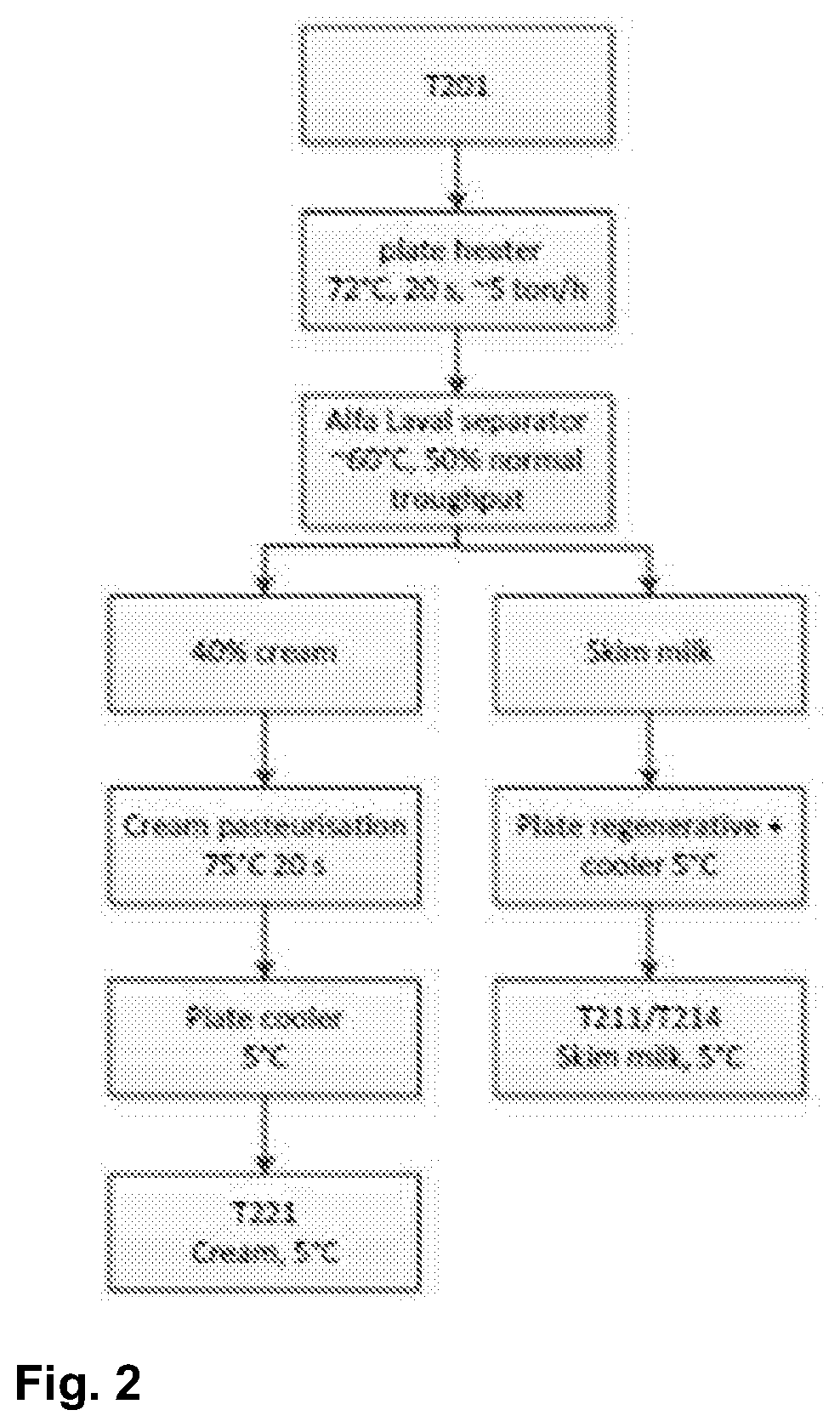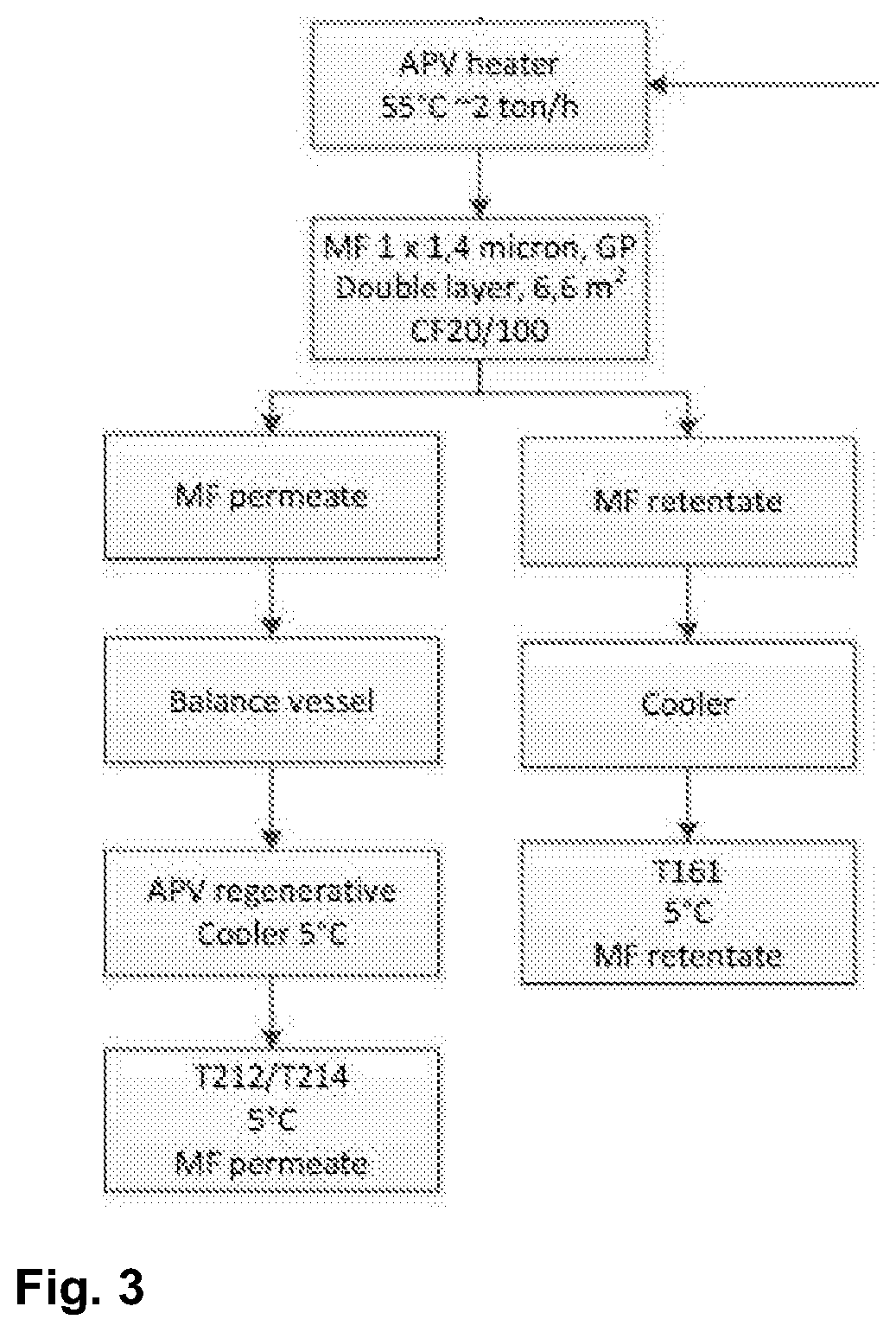Method of removing spores from raw goat milk, process for preparing purified goat milk, goat milk accordingly produced and its use and cheese making method
- Summary
- Abstract
- Description
- Claims
- Application Information
AI Technical Summary
Benefits of technology
Problems solved by technology
Method used
Image
Examples
example 1
[0061]FIG. 1 illustrates an example of an overall process of making purified goat milk, suitable for use as cheese milk, according to the invention. The milk is preheated, as a mild form of pasteurization, at 55° C. and fed into a cream separator. A desired part of the cream thereby obtained is send to a mild cream pasteurization treatment, and is kept in the process. A surplus part of the cream is sent to another cream pasteurizer for separate storage of goat cream. The cream separator is an open centrifuge operated at a flow rate double that of the flow rate by which the raw milk is fed into it. The corresponding additional flow of milk into the separator is provided by a by-pass in a line from the separator to subsequent processing. Via this by-pass the skim milk is recirculated to the cream separator. After having passed through the cream separator twice, the skimmed milk is led to subsequent processing, and is thereby fed into microfiltration unit MF1. This results in spore rem...
example 2
[0062]This example follows a scheme depicted in FIGS. 2-4. After reception of the raw goat milk, the milk is mildly pasteurized according to authority regulations and skimmed (FIG. 2). The skimmed milk is thereby fed into a centrifuge at a rate that is halved to allow for more efficient skimming, thus resulting in a lower fat content of the skimmed milk. After the skimming, the milk is subjected to microfiltration (1.4 μm MWCO) to remove bacteria and spores (FIG. 3, the arrow to the APV heater indicating the supply of skimmed milk). Cream is separately sterilized. The MF retentate is combined with the heavy fraction from the cream separation and subjected to sterilization by heat treatment (yielding a sterilized retentate). The resulting MF permeate, i.e. cell-free milk, is recombined with the cream and the sterilized retentate and standardized to the desired fat / protein ratio, resulting in a purified goat milk, suitable for the production of cheese.
example 3
[0063]Purified goat milk obtained by a process as described in Example 1 is subjected to a cheesemaking process. Thereby the milk is pumped into a curd vat, and starter bacteria and calcium chloride are added. Subsequently, when a desired state of acidification has been reached, rennet is added so as to induce coagulation, resulting in curd. The curd is cut into pieces and washed with warm water. The resulting mass of curd and whey is subjected to draining so as to separate the whey from the curd. The curd is transferred to cheese vats, and is thereby pressed into a mould. Pressure is gradually increased, so as to form a well-closing crust, and more whey is released. Finally, the resulting moulded cheeses are salted in brine and subjected to ripening on wooden shelves.
PUM
 Login to View More
Login to View More Abstract
Description
Claims
Application Information
 Login to View More
Login to View More - R&D
- Intellectual Property
- Life Sciences
- Materials
- Tech Scout
- Unparalleled Data Quality
- Higher Quality Content
- 60% Fewer Hallucinations
Browse by: Latest US Patents, China's latest patents, Technical Efficacy Thesaurus, Application Domain, Technology Topic, Popular Technical Reports.
© 2025 PatSnap. All rights reserved.Legal|Privacy policy|Modern Slavery Act Transparency Statement|Sitemap|About US| Contact US: help@patsnap.com



